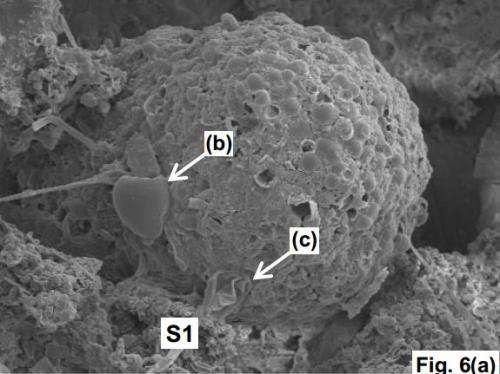March 12, 2013 weblog
Astrobiologists claim meteorite carried space algae

(Phys.org) —A fireball that appeared over the Sri Lankan province of Polonnaruwa on December 29, 2012 was a meteorite containing algae fossils, according to a paper published in the Journal of Cosmology. A team of researchers, led by Jamie Wallis of Cardiff University, believes that these fossils provide evidence of cometary panspermia, the hypothesis that life originated in outer space and comets brought it to Earth.
Scientists at the Sri Lankan Medical Research Institute in Colombo forwarded 628 stone fragments that allegedly fell from the fireball to Cardiff University, where Wallis' team indentified three as originating from a carbonaceous chondrite. The structure of one of the samples led the Cardiff researchers to conclude that the fireball was once a comet.
Electron microscopy revealed what appeared to be fossils of algae embedded within the samples. According to Wallis and colleagues, this confirms that life on Earth had an extraterrestrial origin. The researchers even claim that what look like unusually long, thin flagella are proof that the microorganisms in the meteorite evolved in a low gravity, low pressure environment.
Critics argue that there could be a simpler explanation. Modern organisms could have contaminated the samples. However, the researchers state that low levels of nitrogen in the fragments and the position of the fossils deep within the rock matrix indicate that the fossils are of ancient origin.
It is not even certain that the samples came from the fireball. The reported trajectory of the fireball and eventual landing place of the fragments came from eyewitness accounts, which can be unreliable.
According to skeptics, lightning strikes could have formed the stones. However, Wallis and his colleagues say there were no reports of lightning at the time, and heat generated by lightning would have destroyed the fossils.
Another possibility is that the fireball originally came from Earth. A long ago asteroid impact could have ejected rocks and water with biological material into space. Some of this ejected material could have reappeared in the atmosphere last December.
Incredibly, all of the fossils found in the samples were of freshwater species that live on Earth. Their origin in space would imply that they had the same evolutionary history as their terrestrial cousins—remarkable considering their vastly different environments.
The Journal of Cosmology itself has a less than perfect reputation. In 2009, it published a paper claiming meteorites contained fossil-like cyanobacteria. Critics also greeted this study with skepticism.
In addition, one of the paper's coauthors, Chandra Wickramasinghe, was the first to propose the panspermia hypothesis in 1981. Skeptics claim that he is fanatical about the concept, to the point of ignoring contradictory evidence.
More information: The Polonnaruwa meteorite: oxygen isotope, crystalline and biological composition, arXiv:1303.1845 [q-bio.OT] arxiv.org/abs/1303.1845
Abstract
Results of X-Ray Diffraction (XRD) analysis, Triple Oxygen Isotope analysis and Scanning Electron Microscopic (SEM) studies are presented for stone fragments recovered from the North Central Province of Sri Lanka following a witnessed fireball event on 29 December 2012. The existence of numerous nitrogen depleted highly carbonaceous fossilized biological structures fused into the rock matrix is inconsistent with recent terrestrial contamination. Oxygen isotope results compare well with those of CI and CI-like chondrites but are inconsistent with the fulgurite hypothesis.
via Arxiv Blog
© 2013 Phys.org




















